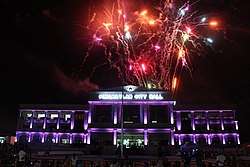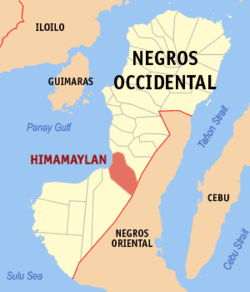Himamaylan
Himamaylan (/hiːmɑːˈmaɪlən/), officially the City of Himamaylan (Hiligaynon: Dakbanwa/Syudad sang Himamaylan; Tagalog: Lungsod ng Himamaylan), is a 3rd class component city in the province of Negros Occidental, Philippines. According to the 2015 census, it has a population of 106,880 people.[3]
Himamaylan Dakbanwa sang Himamaylan | |
|---|---|
| City of Himamaylan | |
 Himamaylan City Hall | |
 Seal | |
| Nickname(s): Maylan Home of Himaya-an Festival and Patik Kawayan | |
| Motto(s): Onward To More Progress | |
 Map of Negros Occidental with Himamaylan highlighted | |
OpenStreetMap 
| |
.svg.png) Himamaylan Location within the Philippines | |
| Coordinates: 10°06′N 122°52′E | |
| Country | |
| Region | Western Visayas (Region VI) |
| Province | Negros Occidental |
| District | 5th district of Negros Occidental |
| Founded | 1575 |
| Cityhood | March 5, 2001 |
| Barangays | 19 (see Barangays) |
| Government | |
| • Type | Sangguniang Panlungsod |
| • Mayor | Rogelio Raymund I. Tongson Jr. |
| • Vice Mayor | Justin Dominic S. Gatuslao |
| • Congressman | Maria Lourdes Arroyo-Lesaca |
| • Electorate | 68,213 voters (2019) |
| Area | |
| • Total | 367.04 km2 (141.71 sq mi) |
| Population (2015 census)[3] | |
| • Total | 106,880 |
| • Density | 290/km2 (750/sq mi) |
| • Households | 25,229 |
| Economy | |
| • Income class | 3rd city income class |
| • Poverty incidence | 19.76% (2015)[4] |
| • Revenue (₱) | 552,994,367.52 (2016) |
| Time zone | UTC+8 (PST) |
| ZIP code | 6108 |
| PSGC | |
| IDD : area code | +63 (0)34 |
| Climate type | tropical climate |
| Native languages | Hiligaynon Tagalog |
| Website | himamaylancity |
This component city located is 83 kilometres (52 mi) south of Bacolod, the provincial capital. Due to its coastal location, it is a rich source of different types of seafood, mainly fish, oysters, mussels and shrimps. The city celebrates the Himaya-an Festival every April 14–25.
Himamaylan became a city on March 5, 2001, through a proclamation by President Gloria Macapagal Arroyo under Republic Act No. 9028. It is the only city in the 5th District of Negros Occidental.
Etymology
The term "Himamaylan" is a portmanteau of the two Hiligaynon words hima and babaylan. It is alleged that the settlement's early Malay inhabitants suffered from a foot malady called hima, and their employment of witch doctors called babaylan caused the Spanish occupiers to call them Himamaylan.[5][6]
History
In 1795, Himamaylan became the capital of Negros.[7] At that time, the city served as a garrison for occupying Spanish forces. Today, the old Spanish-built fort constructed as a lookout point for frequent Moro raids is one of the historical attractions found in the city.[5]
In 2001, the Philippine Congress passed Republic Act No. 9028, providing for the conversion of the municipality into a city after a favorable plebiscite.
Geography
Himamaylan is located at the center-most cove on the coastline of Negros Island. Himamaylan has a natural harbor characterized by deep waters favorable to access by marine vessels.
Located in the center of the island, the city is conducive to operations reaching all parts of the country and the rest of Southeast Asia from a strategic point. Most portions of the city are plains and generally have fertile soil, conducive for agriculture. The city's rivers are 12 feet (3.7 m) or deeper, providing drainage for farmland.
Barangays
Himamaylan City is politically subdivided into 19 barangays.
- Aguisan
- Buenavista
- Cabadiangan
- Cabanbanan
- Carabalan
- Caradio-an
- Libacao
- Mambagaton
- Nabali-an
- Mahalang
- San Antonio
- Sara-et
- Su-ay
- Talaban
- To-oy
- Barangay I (Poblacion)
- Barangay II (Poblacion)
- Barangay III (Poblacion)
- Barangay IV (Poblacion)
Climate
| Climate data for Himamaylan City, Negros Occidental | |||||||||||||
|---|---|---|---|---|---|---|---|---|---|---|---|---|---|
| Month | Jan | Feb | Mar | Apr | May | Jun | Jul | Aug | Sep | Oct | Nov | Dec | Year |
| Average high °C (°F) | 30 (86) |
31 (88) |
32 (90) |
33 (91) |
32 (90) |
30 (86) |
29 (84) |
29 (84) |
29 (84) |
29 (84) |
30 (86) |
30 (86) |
30 (87) |
| Average low °C (°F) | 22 (72) |
22 (72) |
22 (72) |
24 (75) |
25 (77) |
25 (77) |
25 (77) |
24 (75) |
24 (75) |
24 (75) |
23 (73) |
23 (73) |
24 (74) |
| Average precipitation mm (inches) | 38 (1.5) |
29 (1.1) |
55 (2.2) |
65 (2.6) |
141 (5.6) |
210 (8.3) |
212 (8.3) |
176 (6.9) |
180 (7.1) |
180 (7.1) |
130 (5.1) |
70 (2.8) |
1,486 (58.6) |
| Average rainy days | 9.0 | 7.2 | 11.1 | 13.5 | 25.6 | 28.4 | 28.9 | 27.3 | 26.9 | 27.7 | 21.8 | 13.8 | 241.2 |
| Source: Meteoblue [8] | |||||||||||||
Demographics
| Year | Pop. | ±% p.a. |
|---|---|---|
| 1903 | 14,932 | — |
| 1918 | 15,559 | +0.27% |
| 1939 | 28,407 | +2.91% |
| 1948 | 33,984 | +2.01% |
| 1960 | 41,985 | +1.78% |
| 1970 | 53,663 | +2.48% |
| 1975 | 65,521 | +4.09% |
| 1980 | 70,467 | +1.47% |
| 1990 | 81,014 | +1.40% |
| 1995 | 83,268 | +0.52% |
| 2000 | 88,684 | +1.36% |
| 2007 | 102,014 | +1.95% |
| 2010 | 103,006 | +0.35% |
| 2015 | 106,880 | +0.71% |
| Source: Philippine Statistics Authority[3][9][10][11] | ||
The people in the city speak the Hiligaynon language (often called Ilonggo). Filipino and English are generally understood.
Economy
The city's main sources of livelihood include fishery, sugarcane farming and sugar production, rice farming, mango cultivation and ethanol exports.[6]
References
- "City". Quezon City, Philippines: Department of the Interior and Local Government. Retrieved 30 May 2013.
- "Province:". PSGC Interactive. Quezon City, Philippines: Philippine Statistics Authority. Retrieved 12 November 2016.
- Census of Population (2015). "Region VI (Western Visayas)". Total Population by Province, City, Municipality and Barangay. PSA. Retrieved 20 June 2016.
- "PSA releases the 2015 Municipal and City Level Poverty Estimates". Quezon City, Philippines. Retrieved 12 October 2019.
- "Negros Occidental, Himamaylan City". Archived from the original on 2008-06-12. Retrieved 2008-09-02.
- "About Himamaylan City". Retrieved 2008-09-02.
- "Inside Negros: Himamaylan City". Archived from the original on 2008-09-02. Retrieved 2008-09-02.
- "Himamaylan: Average Temperatures and Rainfall". Meteoblue. Retrieved 7 May 2020.
- Census of Population and Housing (2010). "Region VI (Western Visayas)". Total Population by Province, City, Municipality and Barangay. NSO. Retrieved 29 June 2016.
- Censuses of Population (1903–2007). "Region VI (Western Visayas)". Table 1. Population Enumerated in Various Censuses by Province/Highly Urbanized City: 1903 to 2007. NSO.
- "Province of". Municipality Population Data. Local Water Utilities Administration Research Division. Retrieved 17 December 2016.